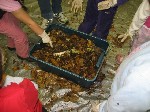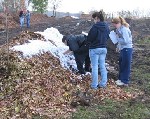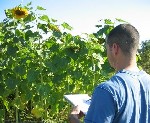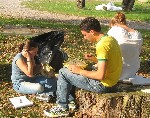News & Events
Education Justifies the Field Station
Posted on Monday, November 26, 2007
The Mission Statement of the Field Station clearly identifies education as its primary function. All else has to fit into that priority. A dozen or more Westminster classes make use of the building and grounds. But education is not limited to college classes. That is the beauty and substance of what happens here with pre-school through adult education. There is something for everyone!
As a part of the "Make a Difference Day" at Westminster on October 26, preschool children led by Mrs. Diana Reed and half a dozen parents and staff came to spend time, of all things, getting dirty! These children were given latex gloves and told to pitch into a small bin what they believed would make good dirt, a.k.a., compost. They did well in identifying biodegradable food and other waste but they didn't use the word "biodegradable." The detailed meaning of that word will come later in life. They learned the word "microorganisms" and developed a simple grasp of living things far smaller than the eye can see that are good for the environment and us. This was " . . . a celebration of neighbors helping neighbors . . . everyone can participate." That line is the stated goal of Make a Difference Day, America's largest day of volunteering coast to coast. And, yes, we are neighbors! Here are quotes from three of the 18 preschoolers that show what they learned: "I loved throwing all the old food into the pile...there was pizza, oranges and paper"; "I liked the worms eating the stuff"; and "My favorite thing was putting everything in! I loved the field trip!"
We talked about composting and how a good neighbor would re-use their garbage to feed the earth. Children, when properly educated, will learn that making dirt out of things we might throw away is not hard to do, it just takes time! After adding all of the compostables to a bin they stirred it with gloved hands. That bin, a microcosm of what happens on a large scale at the Field Station, is now in the classroom reminding them as they stir it each week that a little effort can make a big difference.
Before Thanksgiving two college biology classes hiked the trail from the main campus to the Field Station. The classroom was outdoors. These students mastered details of composting that extended beyond the level of the pre-schoolers. They learned about carbon-rich and nitrogen-rich feedstocks as well as C/N ratios. They mastered the use of equipment to test pH and temperature of the composting rows in different stages of maturity. They learned to apply the concepts of anaerobic and aerobic respiration. Activities at the Field Station integrate theory and practice, textbook and reality.
The Field Station is a great place to learn through the eyes of different disciplines. Art students this fall concentrated on color and patterns in the floral structures of sunflowers. Their sketches and drawings communicated these patterns as objects of art. Population Ecology students examined these same sunflower heads and analyzed the patterns of the fruits, called achenes, in each head to see if they fit into the Fibonacci number sequence.
The Field Station illustrates that there is so much to learn directly from nature! Louis Agassiz, a Harvard biologist of the late 19th Century, put it this way, "Study nature, not books." Claude Monet, the French Impressionist painter also of the 19th Century, said, "The richness I achieve comes from Nature, the source of my inspiration." Perhaps in the flow of children and adults through the activities of the Field Station we'll see another Agassiz or Monet in the 21st Century!
Clarence Harms, Director
Field Station




More Stories



